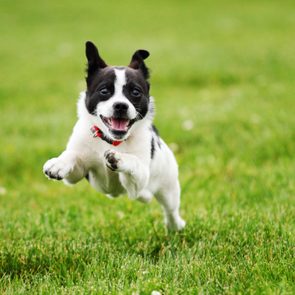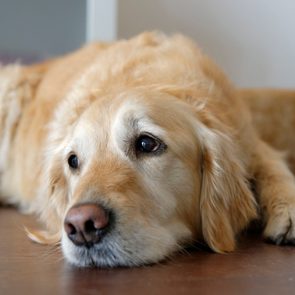Why Do Dogs Twitch in Their Sleep?
Updated: Jan. 12, 2024

When dogs jerk around while they're dozing, you may wonder if they're running, dreaming or in pain. Here's what pros have to say about these sleepytime moves.
Dogs do the darnedest (and cutest) things, but sometimes those adorable doggy behaviors leave us with a bunch of questions. Like, why do dogs shake for no apparent reason? Why dogs hate cats? Why are they so afraid of thunderstorms? why do they drag their butts? And when they sleep (and they sleep a lot), what do they dream about? You might have also noticed that dogs often make little movements when they’re snoozing and wondered what’s going on there. Why do dogs twitch in their sleep, and should you be concerned about it?
The first thing you should know is that this behavior is very common. “Dogs have been observed whining, moving their legs either gently or even fast, as if they were running,” says Paola Cuevas, DVM, a veterinarian and animal behaviorist at PetKeen.
Your pet may also make facial expressions when they get hiccups or are snoozing and twitching. But maybe you’re worrying that twitching is one of the warning signs that your dog is in pain? We asked veterinarians to help us decode what dog twitching really means.
Get Reader’s Digest’s Read Up newsletter for more pet insights, humor, cleaning, travel, tech and fun facts all week long.
Why do dogs twitch in their sleep?
As bizarre as it looks, there’s a simple answer: “When dogs twitch in their sleep, it is because they are dreaming,” says Amber Karwacki, DVM, a veterinarian at Heart+Paw.
Scientists have studied and measured the sleeping brain of dogs, and as it turns out, dogs go through the stages of sleep much like humans do, says Dr. Karwacki. When humans reach the rapid eye movement (REM) stage of sleep, which is when we dream vividly, it’s normal for there to be movement in the body. The same goes for our furry friends. “During the REM phase, brain waves are irregular and fast,” says Dr. Cuevas. “Our observations of dogs’ movement and vocalization during their REM sleep let us conclude that they have dreams.”
Dogs may also “talk” in their sleep with muffled barks, and act out their dreams by moving their legs in the same manner humans do when we are dreaming. What’s interesting (and enviable, if we’re honest) is that dogs hit that coveted deep sleep of REM much faster than we do. It takes them only 20 minutes to get there, and it’s about 90 minutes for us.
Is it OK for dogs to twitch in their sleep?
In a word, yes. And when dogs twitch in their sleep, we don’t need to do a thing, says Dr. Karwacki. It’s totally normal, even when it looks like our angelic pups are in distress. Still, it does make you wonder if they are dreaming of good things like chewing on a bone and playing fetch, or scary stuff like loud fireworks and rumbling thunderstorms.
Though experts don’t know for sure what dogs dream about, it’s probably similar to our dream themes—a mashup of daytime reality infused with other memories. “Owners’ knowledge of their dogs’ habits, behavior and favorite activities points toward the direction that dogs dream about stuff they experience in their lives, things they enjoy and things they fear,” says Dr. Cuevas.
Is twitching ever a cause for concern?
Only if the dog is awake. Twitching during REM sleep is totally normal, but twitching when they’e not snoozing could be a sign of a brain-health problem. Epilepsy is a neurologic condition that can cause seizures, which can look a lot like the twitching your pup does while they’re sleeping.
“If the dog twitches while awake, it could be anything from a metabolic issue to a neurologic issue,” says Randall Cannon, DVM, a veterinarian at Cannon Veterinary Services in Orlando, Florida. If twitching is happening in one particular part of the body, it could still be neurologic, “but there also could be a local problem, such as discomfort or a nerve issue,” he says.
When your dog is twitching while asleep, take note of its body language. “Sleeping dogs are usually in a relaxed body position, while dogs experiencing a seizure or other medical condition are usually in a tense or rigid body position,” says Dr. Karwacki.
How can you tell the difference between twitching and seizures in dogs?
It’s pretty simple: Twitching occurs when a dog is sleeping. Dog seizures happen when dogs are awake and their eyes are open. Seizures run the spectrum of varying degrees of severity. “It could be as simple as heavy salivating all the way to a grand mal seizure with violent muscle contractions and relaxations over the entire body,” says Dr. Cannon.
In mild seizures, dogs may have a dazed look, lick their lips and twitch. When a dog experiences a full-blown grand mal seizure, they lose consciousness and may fall over on their side and paddle their legs while the rest of the body is stiff. They may stare blankly into the distance, drool excessively and not respond to their name.
As scary as it is to witness, a seizure isn’t painful and usually lasts only a couple of minutes. Naturally, your first instinct is to comfort and pet them, but it’s actually better to let them be. After all, they are unaware of what is happening during a seizure and may unintentionally bite. Instead, stay close to make sure they don’t hurt themselves.
If your dog has never had a seizure before or if it lasts more than five minutes, call your vet right away. Whether mild or severe, your vet will want more details on the events leading up to the seizure. Take notes and, if possible, a short video to help your vet diagnose and treat them properly.
Should I wake up my dog if he’s twitching?
Nope. “I lean into the old adage ‘Let sleeping dogs lie’ when it comes to waking dogs up,” says Kelly Diehl, a veterinarian and senior director of science communication at Morris Animal Foundation. “It’s better to let the episode pass.”
If you’re worried about your pup being upset by a bad dream, don’t be. Experts aren’t 100% sure if dogs even have nightmares, so waking them up could cause more harm than good. “Startling a dog out of sleep can trigger an aggressive response in many dogs, putting the owner at risk of a dog bite,” says Dr. Diehl. Be sure to convey this to kids, who might be tempted to hug or kiss a dog that’s sleeping.
That said, Dr. Diehl admits that on rare occasions she’s ignored her own advice when her dogs had a particularly active sleep cycle. She wakes them safely by softly calling their name a few times from across the room, without touching or getting too close.
Do some dogs twitch in their sleep more than others?
Yes, but it depends more on the age of the animal than the breed. Dr. Diehl says no scientific evidence suggests a particular breed is more prone to twitching, but puppies and older dogs may twitch more. “I’ve seen an increase in vocalization and twitching in my own dogs as they’ve aged,” she notes, “and there is some scientific data that suggests puppies and older dogs have brain configurations that make this possible.”
Is there anything you can do to stop the twitching?
As we mentioned, you can wake a dog to stop twitching, but there’s really no need to interrupt their puppy dreams. Dogs (and people!) need solid slumber for a healthy mind and body. Plus, waking them from a deep REM sleep can be startling to your fuzzy dreamer.
But if your dog sleeps with you, their constant twitching is probably waking you up, and then no one is getting a good night’s sleep. It’s a better idea to buy a comfy dog bed to put in your bedroom or in another quiet area where they won’t be disturbed. That way, you can both get your beauty sleep.
Sources:
- Paola Cuevas, DVM, animal behaviorist at PetKeen
- Amber Karwacki, DVM, veterinarian at Heart+Paw
- Randall Cannon, DVM, veterinarian at Cannon Veterinary Services in Orlando, Florida
- Kelly Diehl, DVM, senior director of science communication at Morris Animal Foundation






















